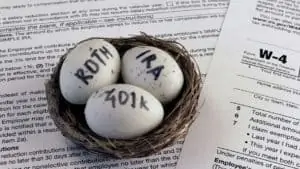I’ve mentioned here before about the new drivers in our house, Sophie and Phoebe. I won’t lie to you that I have to get mentally prepared before hopping into that passenger’s seat with my new drivers
Seriously, it’s a great feeling to see your children learn something new and gain more freedom and independence. I remember how liberating it felt when I finally passed my own driver’s test and my mom reluctantly handed me the keys to her 1982 red Reliant K car for a solo run. Heck, the car didn’t have air conditioning, only AM radio, and the plastic seats stuck to your body on those warm summer days. I didn’t care . . . I was free
So, of course, Sophie and Phoebe have also heard this from me – over and over. It’s good advice, and I hope they repeat it in their heads when they’re driving, too!
Hmmm . . . this got me thinking
It got me thinking about planning for retirement, and how a theoretical “blind-spot” can cause a retirement “accident”. I got thinking about how certain factors and events that linger in the background during retirement that could derail any carefully planned retirement unless we know about them and can anticipate them. In my 13 years in private practice and over 25 years in the financial industry, I’ve learned 4 common risks, or blind-spots, that many folks forget to pay attention to once they’ve started retirement. So this week, let’s spend our time together on some blind-spots that may be relevant to you.
The first is Market Risk. This is a big one. We all expect our portfolio to have gains and losses due to market movement while we’re in the accumulation phase of our financial lifecycle. But folks, you cannot have those significant fluctuations and losses when you are in the distribution phase of your lifecycle. The investment component of your retirement system must incorporate quantitative data to give your strategy the highest probability of financial success. I find that many folks approaching or actually in retirement are still using an outdated accumulation buy and hold strategy, opening themselves up to potentially significant losses, as we’ve seen in the past. An inappropriate accumulation investment strategy being used in the distribution years may lead to that – bam!
This is why your investment mindset needs to change when you enter the distribution phase – when you start drawing from your retirement assets. Think of your retirement assets as a fund
Inflation is another blind-spot that, if anticipated and planned for, can be managed. Ben Bernanke, the old Federal Reserve Chairman referred to inflation as the “silent killer”. While inflation has been relatively low in the last few years, a 2-3% inflation rate makes a big difference over time. Inflation causes the costs of goods and services to rise over time, so your money buys less in the future.
For example, if you retired 20 years ago, in 1999, you would have seen inflation rise by 54% – so you would actually need $1.54 today to purchase what cost you just $1 in 1999. And remember, inflation for one demographic may look very different than for another. For example, items such as food and healthcare tend to run higher than the national rate and generally represent a larger share of a senior’s total household expenses. You know what is inflationary to folks like me . . . college for my kids! An inflationary number that is also larger than the national rate.
And then we have taxes. Just as you might look at your annual salary and realize that this doesn’t equal your actual take-home pay, your retirement accounts work the same way. Any money in qualified (tax-deferred) retirement plans will be reduced by ordinary income taxes. And this could include both federal as well as state taxes.
It doesn’t end there. Other taxes that must be considered are possible taxes to your Social Security benefits or pension income, as well as capital gains taxes on non-qualified assets. Other considerations include property and excise taxes; if you live in a high-tax state, these taxes can take a significant chunk out of your household budget. Pay attention to all of these taxes, so they don’t sneak up on you in retirement and wreak collective havoc.
And last, but certainly not least,
So, folks, be sure to check for your blind-spots as you are transitioning from your accumulation years to your distribution years. Distribution planning in your financial lifecycle is critical in order to help put you in the highest probability or retirement success. After all, you might not even know a risk exists if you aren’t looking for it. A little preparation now can help you see and manage your blindspots, both now and in retirement.
And that’s why my advice is always the same: Be vigilant and stay
Have a great week!
Jeff Cutter, CPA/PFS is President of Cutter Financial Group, LLC, an SEC
Registered Investment Advisor with offices in Falmouth, Duxbury, Mansfield & Southlake, TX. Jeff can be reached at jeff@cutterfinancialgroup.com.
This article is intended to provide general information. It is not intended to offer or deliver investment advice in any way. Information regarding investment services is provided solely to gain a better understanding of the subject of the article. Different types of investments involve varying degrees of risk. Therefore, it should not be assumed that future performance of any specific investment or investment strategy will be profitable. Market data and other cited or linked-to content in this article is based on generally-available information and is believed to be reliable. Cutter Financial does not guarantee the performance of any investment or the accuracy of the information contained in this article. Cutter Financial will provide all prospective clients with a copy of Cutter Financial’s Form ADV 2A and applicable Form ADV 2Bs. Please contact us to request a free copy via .pdf or hardcopy. Insurance instruments offered through Cutter Insure, Inc.






